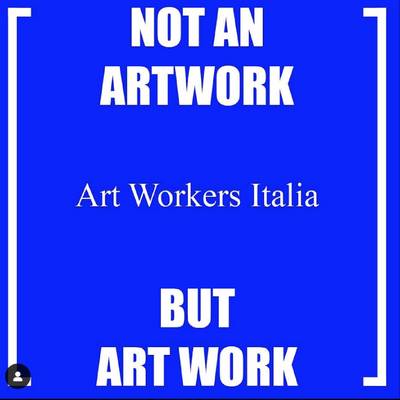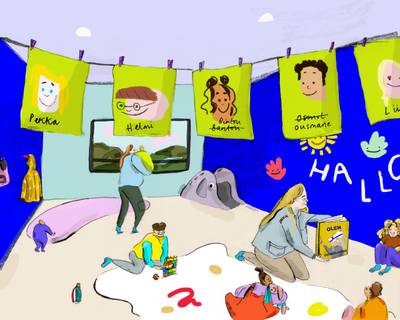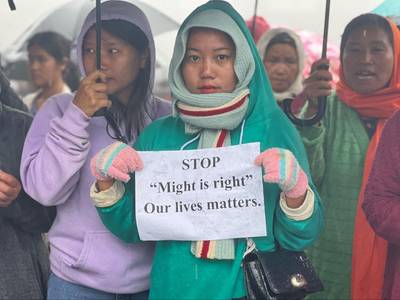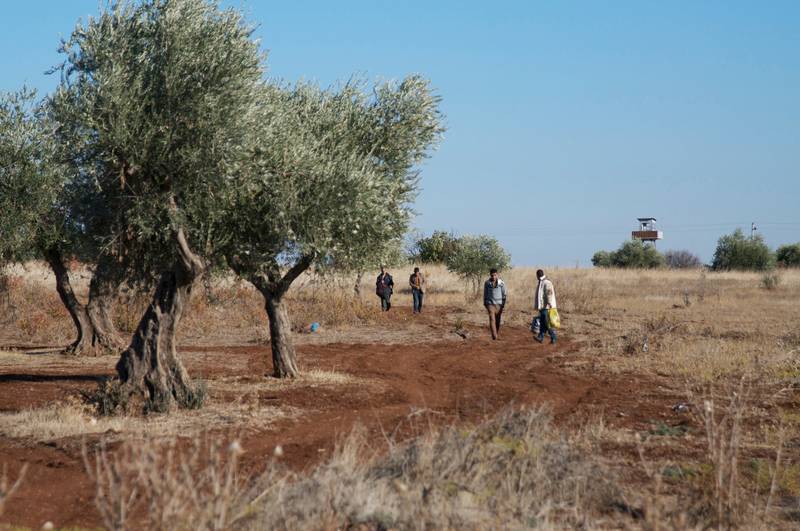

Gaziantep-Aleppo border landscape, 2014. Courtesy Kemal Vural Tarlan and Kitchen Workshop, Gaziantep. Photo: Kemal Vural Tarlan
Merve Bedir is an architect and founding member of the Kitchen Workshop and Center for Spatial Justice in Turkey. Her work revolves around infrastructures of hospitality and mobility. She has a PhD from Delft University of Technology and a BArch from Middle East Technical University, Ankara.
In the border region of Turkey and Syria, people who are already vulnerable are asked to be more resilient and to endure the pain, disaster after disaster. While the response of formal relief networks during disasters – for instance the displacement from Syria (2011-), the Covid-19 pandemic (2019), and the February 6th earthquakes (2023) – have shown their ineffectiveness, people on the margins create and sustain the translocal and self-organized networks of mutual aid for survival. To be clear, there is nothing natural about these disasters but they are results of the underlying infrastructures and injustices that push all living beings to the brink of extinction.
I’m an architect, raised in Turkey and living in the Netherlands, and have been volunteering for an NGO, Kırkayak Kültür, in Gaziantep since the revolution in Syria. I had started working with migration in 2012/3 when I initiated a research and curatorial project ‘Vocabulary of Hospitality’ in Istanbul. The people I met during this time and following their mobility led me to Gaziantep, a city on the Turkey side of the border with Syria, across from Aleppo. There, I started volunteering for Kırkayak Kültür and, in 2015, joined a collective of women to eventually initiate the Kitchen Workshop. Here, I want to acknowledge them, and the people of the region who, despite perpetual displacement and dispossession, uphold human rights and the rights of other living beings to coexist. While I write this contribution on my own behalf with no claim to speak for them, my voice inevitably connects to these collectivities that I am part of. My aim here, and hope, to emphasize the significance of the mutual aid networks, who demonstrate the necessity and potential for creating plural and just futures against the deepening systems of oppression, racism, and discrimination that disasters exacerbate. Then I aim to highlight the necessity to create futures in the region, which are anti-colonial, anti-feudalist, anti-nationalist, and anti-capitalist.
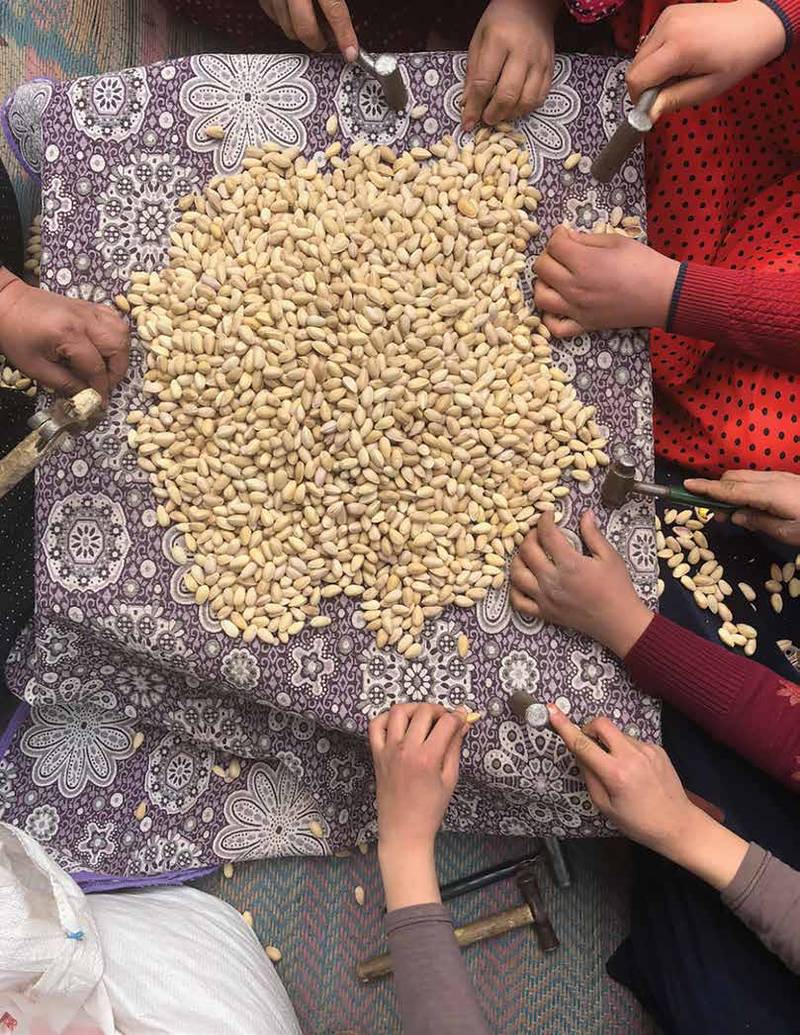

Voice of the Women Agency: Women’s Labour during the Pandemic, 2020. Courtesy Damla Deniz Cengiz and Kitchen Workshop, Gaziantep. Photo: Damla Deniz Cengiz
(Auto)colonising Infrastructures and a Not-so-natural Disaster
In her text, A death that reminds suicide I and II (2023), Ayşe Çavdar explains the consequential destruction of the February 6 earthquakes (2023) across Turkey and Syria, through the new urban religious class who is heavily invested in the construction sector, in relation to the rapid urbanisation and its financial economy in Turkey. To understand the contextual dynamics of why these earthquakes were not-so-natural, I want to highlight Çavdar’s analysis on the related agents of urbanization, i.e. politicians, technocrats, disciplinary practitioners, workers, and inhabitants. I need to add a few things on the context.
Firstly, Pazarcık, the epicentre of the main earthquakes of February 6, is the base location upon which calculations of seismic movement, and calculations of stability and resilience for built structures are made. The size and the epicenter of these earthquakes has been ‘the model’ of these calculations in the region for decades. (In static and seismics ‘the model’ calculation refers to the maximum known limits of a disaster.) This means, there have been good scientists and available technology to monitor, analyze, and warn for the possible disaster, in order for other responsible agencies to prepare for it.
Secondly, these earthquakes need to be evaluated in context of the 2012- Law for Transformation of Areas Under Disaster Risk (commonly known as Disaster Law). This law and the period in preparation (since 2010) describe a condition of accelerated urbanization, life and environment as only urban, imposed on peoples, who are displaced, who are from the periphery and marginalized, who are from other race, ethnicity and religion. People, whose lives have been organized between formal and informal, across urban and rural, across agriculture and seasonal work, across indigeneity and industry, were left with the only option of becoming urban. In the larger politico-economical context of this law, villages were declared urban neighbourhoods, agriculture was de-incentivized, construction was made a pillar of economy, people were offered a future between urban poverty and seasonal work, while cities grew into concrete, and landscapes were offered a future between excavation (for construction and mineral extraction) and obsolescence (from agricultural production).
Concrete is the primary material and system of contemporary construction that no one questions, while the knowledge of so many other methods of construction is unseen. The entrepreneurs who have worked in construction as a business in the previous twelve years because it’s lucrative, or the building inspection mechanisms that have unseen the cheap and dangerous building processes, or the citizens who have undergone heavy mortgage schemes to live in new houses, more ‘modern’ buildings, unseeing the ancestral knowledge about their geographies about where and how to live. So, I dare to say that this is a collective suicide, in which there are many casualties but also many that are complicit.
Such spectral dimensions of the (auto)colonial infrastructures surfaced with the earthquakes. The threshold of pain and vulnerability was the “status-less” peoples’ endurance to disaster after disaster, in the ruins of the empires, under dysfunctional nation-state regimes. The result is a further extinction of the peoples and histories, knowledge and cultures in the region.
I also need to add the colonial infrastructures in entanglement to this context, in relation to the earthquakes. First is the colonial imperial context: one of the districts of Gaziantep that completely flattened to the ground in the earthquake had been relocated to its current place as part of the Berlin Baghdad railway construction of the German and Ottoman Empires at the turn of the 20th century. The soil quality in the new location was good for agriculture and 1-2-storey houses, not high-rise apartments. This relocation destroyed agricultural land/soil back then and made way for its future, i.e., the current destruction caused by the earthquake. Second is the colonial modern context: The structural racism against Arabs, Doms, and others in the aftermath of the earthquake. For instance, while everybody else was transferred to containers, Dom people around Gaziantep remained sheltered in tents organised by Turkey’s disaster mitigation and relief agency. Fearing that they would not be rescued or worrying about what would happen to them after being rescued, Syrians have hesitated to voice (in Arabic or Arabic accent) for help from under the rubble in the destroyed buildings.
Such spectral dimensions of the (auto)colonial infrastructures surfaced with the earthquakes. The threshold of pain and vulnerability was the “status-less”1 peoples’ endurance to disaster after disaster, in the ruins of the empires, under dysfunctional nation-state regimes. The result is a further extinction of peoples and histories, knowledge and cultures in the region.
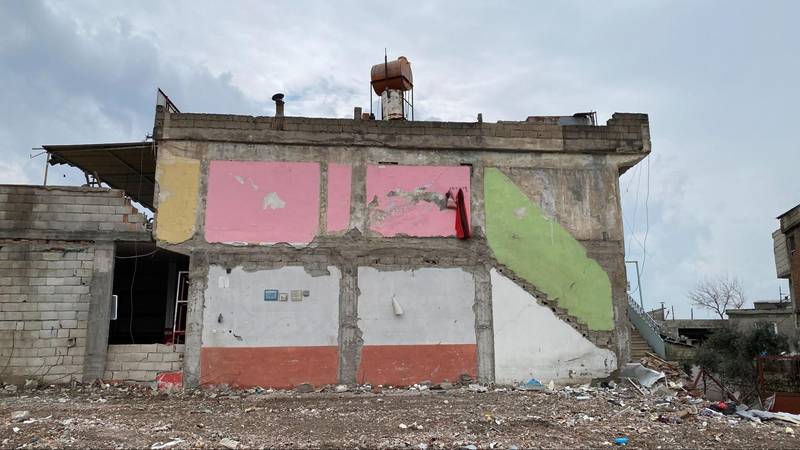

Dwelling plot cleared from rubble in the aftermath of the earthquake, 2023. Courtesy Merve Bedir and Kitchen Workshop, Gaziantep. Photo: Merve Bedir
Surviving Unjust Lands
Gaziantep is one of the largest cities in Southeast Turkey, where one-fifth of the population is from Syria, and part of the city is in the earthquake zone. My engagement in Gaziantep is specific to Kırkayak Kültür, an NGO in the city. They have stated their mission as an organisation for culture, migration, and ecology in their founding in 2011. I have been volunteering for them since 2014-15, after the mass migration and displacement of people from Syria to Gaziantep after the Revolution in Syria. We (the women in Kırkayak Kültür and friends of Kırkayak Kültür) initiated the Kitchen Workshop as a result of a years-long practice of solidarity and conversations on how to engage with the migration from Syria meaningfully. The Kitchen Workshop is where women from Turkey and Syria have been actively working/living with the question of how to live together beyond an understanding of emergency and humanitarian support.
Kırkayak Kültür is in Bey neighbourhood, a former Armenian neighbourhood in Gaziantep. Many buildings in this neighbourhood had been empty for decades after the Armenian genocide (1915-) and, over time, some have been inhabited temporarily by people who were forcefully displaced after the state’s village evacuations in the Kurdish regions of Turkey in the 1990s, as well those who arrived from Idlib, Aleppo, and other cities after the Revolution in Syria (2011). As I see it, the work of Kırkayak Kültür, since its beginnings, is an act of repair, despite the lack of reparations, because their work acknowledges and is actively engaged in the Bey neighbourhood and its people that have been inhabiting and living with the erasures, displacements, and destructions in the last century. Kitchen Workshop tries to think and make space with migrants, looking for sustenance for justice in unjust lands and unconditional hospitality in hostile infrastructures, questioning our position and responsibility within all this. This is, for me, where our friendship stems from.
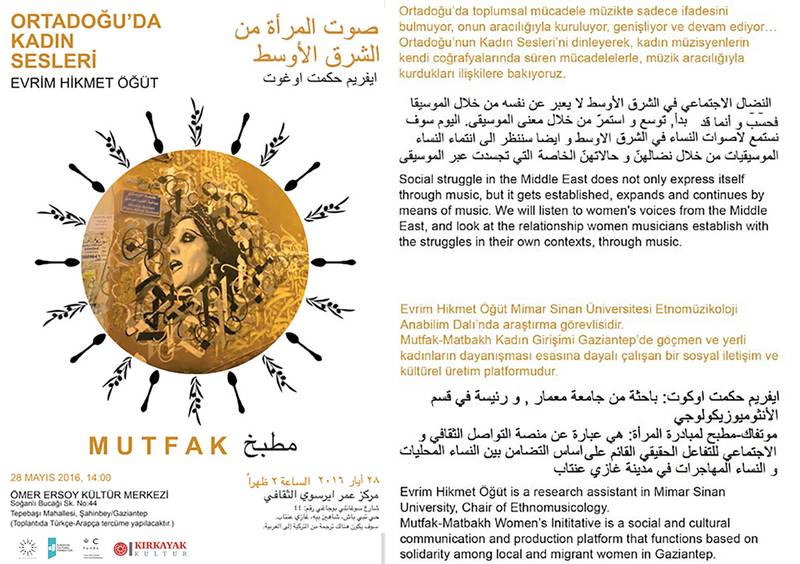

Women’s Voices from the Middle East, poster for a music event by the Kitchen Workshop, 2016. Poster design: Merve Bedir. Courtesy Kitchen Workshop, Gaziantep
In the immediate aftermath of the earthquake, Kırkayak Kültür worked on-site, providing practical assistance such as food, medicine, accessible information, etc., to the marginalised communities that have been invisible to the state. In addition, Kırkayak Kültür has been documenting the cases of racism and discrimination, especially against the migrants from Syria and Dom people, after the earthquake.
I wasn’t in Turkey when the earthquake took place, friends in Kırkayak and Kitchen Workshop advised me not to rush there immediately. Considerable support and aid were being organised by local groups and the diaspora, as well as through digital networks of solidarity, feminist and queer networks of solidarity, and professionals voluntarily serving in their specific expertise. For a moment, this surprised me; I wasn’t expecting the people in the country to be so willing to run for help. Since the 2010s, Turkey has been so polarized into camps, and also dissolved into a kind of individualism, where everybody is only interested in saving themselves, and seeing each other enemies, where it seemed like nothing collaborative/collective could happen even amongst closely connected families, but it was the opposite, the earthquake brought everyone together.
What Is to Be Rebuilt?
Amik Valley is located on the earthquake region and comprises the most resourceful agricultural sites, soil structures, the oldest pistachio and olive trees of the region. Asbestos cloud in the air, Dom people in tents, and construction rubble being emptied/collected into this fertile land are images that are still vivid in my memory… In the aftermath of such a large disaster, repair is very difficult to discuss simply because of the scale and spread of death and damage. An important question is why and what is to repair and rebuild in this context.
Is a “great” repair even possible? How long does it take? What is the scale of its operation? What are its thresholds? This scale of catastrophe brings to light the problems of building in concrete and other assumptions embedded in our work.
A state’s responsibility should be about not letting an earthquake have such consequences. If not to avoid such destruction, if not to avoid the killing of people in the first place, if not to plan for the proper removal of concrete rubble, what is the use of a state? In the aftermath, who repairs what, why and for/with whom? Then, I think of architects, my own profession, who are solution-oriented people. Their default mode of operation is to solve problems rather than asking the fundamental questions. Is a “great” repair even possible? How long does it take? What is the scale of its operation? What are its thresholds? If this scale of catastrophe doesn’t make us question building in concrete or other assumptions embedded in our work, what else will?
Then, the rage is for the people invisible to the state, marginalised, oppressed, living dependent, living in poverty, the people who don’t profit from the rapid urbanisation and its financial economy but who are killed as part of the collective suicide I’ve been referring to, outside their will to participate, and in the aftermath of the earthquake who cannot leave the region because they don’t have the means to, who work in hazardous conditions pulling down the heavily damaged buildings, or who went back to heavily damaged buildings because there was no temporary living space created, or who couldn’t survive the freezing cold in February.


4000-year-old olive seeds found at the Oylum Höyük archaeological site in 2015. Courtesy Atilla Engin, Gaziantep
The Need for Possible Futures
When I arrived in Gaziantep a month after the earthquake, I worked in Nurdağı and Islahiye, two districts that are almost flattened to the ground. Kırkayak Kültür and Kitchen Workshop had been distributing help in these districts. Some members of the Kitchen Workshop, mainly women from Aleppo, started cooking in a restaurant’s kitchen and distributing the food in these districts. This is a paradigm shift, where agency shifts in practice: the migrant helps the citizen, the guest becomes the host, and new life with its values in practice amongst the rubble.
It is important to note that the Kitchen Workshop didn’t start as a kitchen. It was a space of solidarity, a safe space, but more importantly, a space for creating ideas of living together. Kitchen Workshop work with different ways of continuing with these ideals through displacement, racism and discrimination, undocumented work, the COVID pandemic ,then came this earthquake. Among all this is a shared struggle around the rights and collectivity of women, as well as the kind of solidarity practice and mutual aid. Following the work on-site in Nurdağı and Islahiye, we decided to start an industrial kitchen in Gaziantep, one that can cook in mass, and also with a mobile kitchen so it can move and bring food to different places. This also gave the possibility that women who didn’t have the economical means to leave, -because many people who were able to leave, left after the earthquake, or who want to stay in Gaziantep can work there. The idea is to work towards a new life, new practices, and new instituting where you can have non-extractivist values, so it is a desire but also an obligation – that grows on the aftermath of a disaster through the immediate networks of solidarity and mutual aid that create temporary commons.
The knowledge of picking olives, which looks primitive and ancient to the modern state, comes in as knowledge of sustenance but outside the scientific understanding of merit. How to collectively think about the ways of living together, the political agency of communities, and what and who it is to relearn with/from?
In every international, humanitarian aid conference I’ve been part of about major disasters, the immediate discussion is on housing, or let’s say, shelter. I understand this, of course, it’s the most vital need. But I do question at this point if it is ethical to start from there. We need to start from the less profitable discussions, which are about avoiding disasters, avoiding destruction, strengthening buildings, communities, self organisation mechanisms. The moment that such an incident happens in such a scale, there is no state in the first place, to help, and maybe it can’t even help, because it can’t even get to the location immediately simply because of the scale and speed of the operation needed. We need to stop spreading cities and question the size of governance bodies, in relation to geographies. We need to ask why we keep building in concrete, how come it is the easiest and most accessible building material there can be, although it has nothing to do with local materials and techniques, and why we keep building in concrete, even if we know that it a deadly material in earthquake circumstance, and it is not easily recyclable.
Then we need to think on including the existing communities in decision making mechanisms so they can be part of the urgency before it happens. They need to provide ideas and thoughts about how to build and where, what they need, how they want to live. They need learn about what to do in the aftermath of the earthquake, or any other potential/expected disaster, and they need to have an idea of how far the unknown of a disaster can go.
In the border region of Turkey and Syria, people who are already vulnerable are asked to be more resilient and to endure the pain, disaster after disaster. The displacement from Syria (2011-), the Covid-19 pandemic (2019), and the February 6th earthquakes (2023) have revealed that the structures of self organisation are the ones to depend on for survival and the infrastructure of a collective future. But how do we sustain them? How do we transform them from survival structures to infrastructures of collective futures? I would like to think of these infrastructures for the earthquake region but also beyond, thinking of sisters and friends in Iraq, Iran, Syria, Palestine, Lebanon, Jordan, Egypt, and further, also referring to an agency of diasporas in the world we live in.
Who has the right to repair, but also who has the right to construct? Who has the knowledge and merit? I’m thinking of this one instance where women from Idlib in the Kitchen Workshop taught women from Gaziantep how to pick olives. Because Turkey has modernised agriculture, people don’t use the old techniques anymore, so they are out of practice and forgotten. The knowledge of picking olives, which looks primitive and ancient to the modern state, comes in as knowledge of sustenancce after the earthquake, and is precious though outside the scientific understanding of merit because it is not formalised through the institutions. This doesn’t make it any less valuable. How to collectively think about the political agency of communities, what and who it is to relearn with/from.
